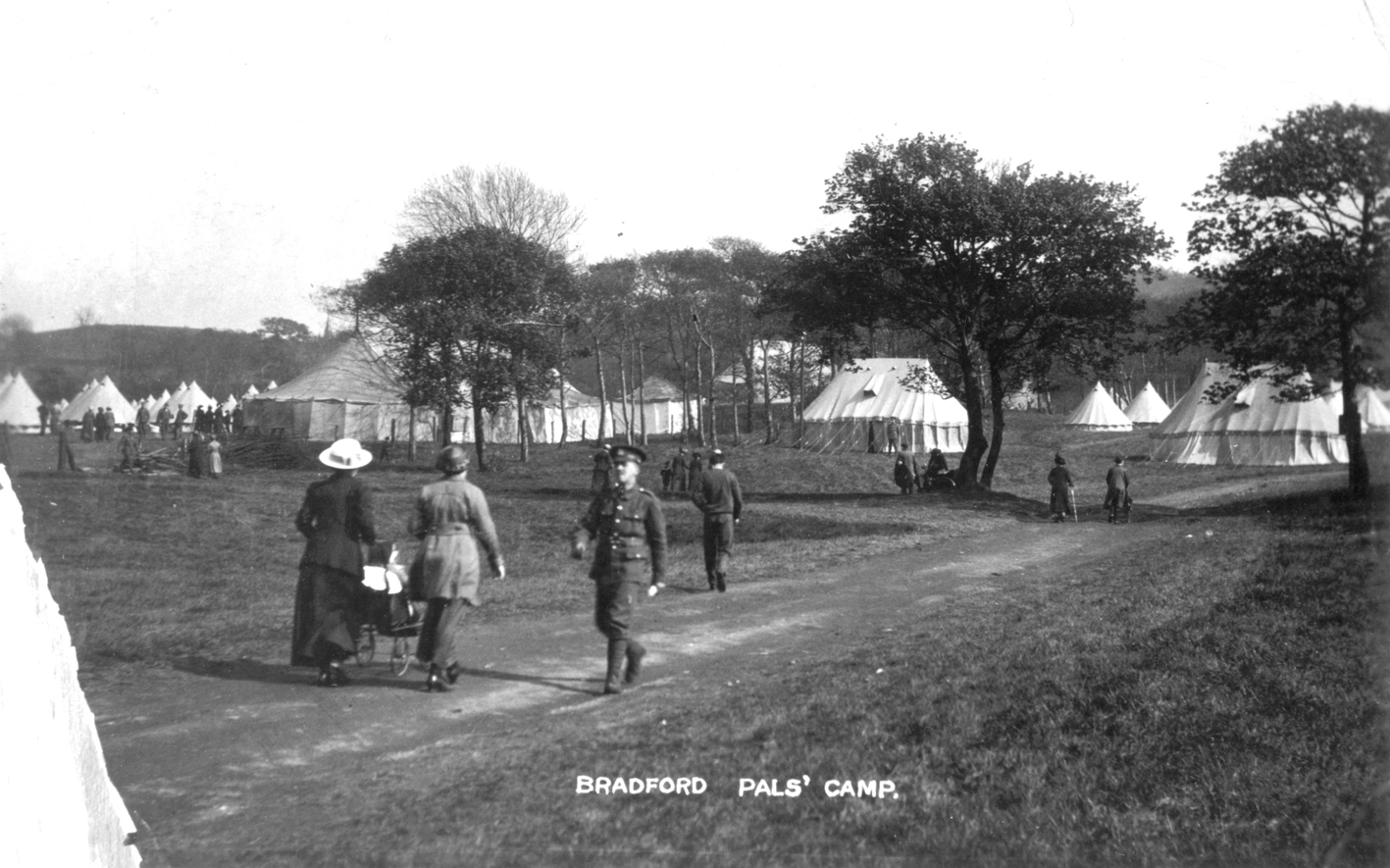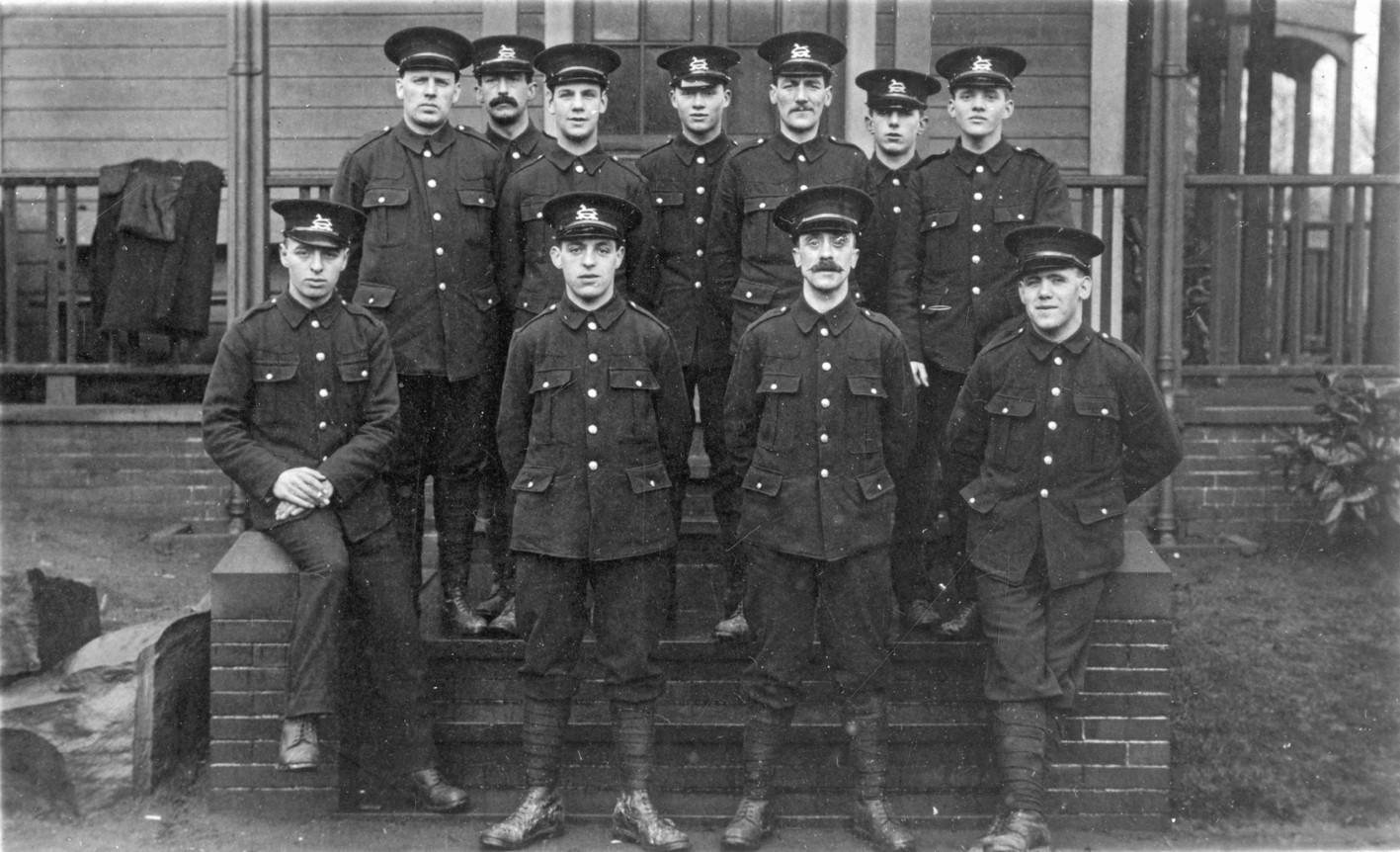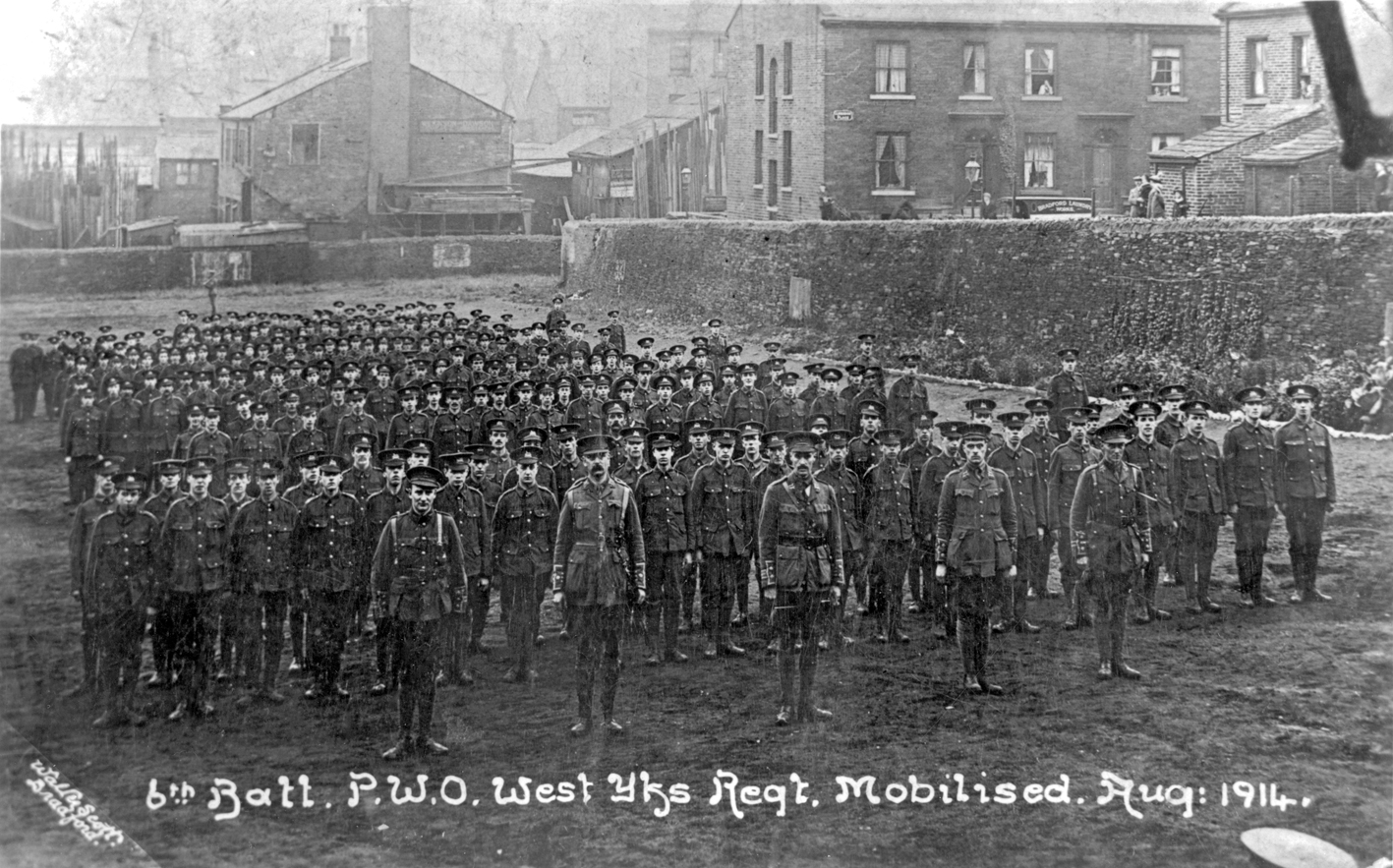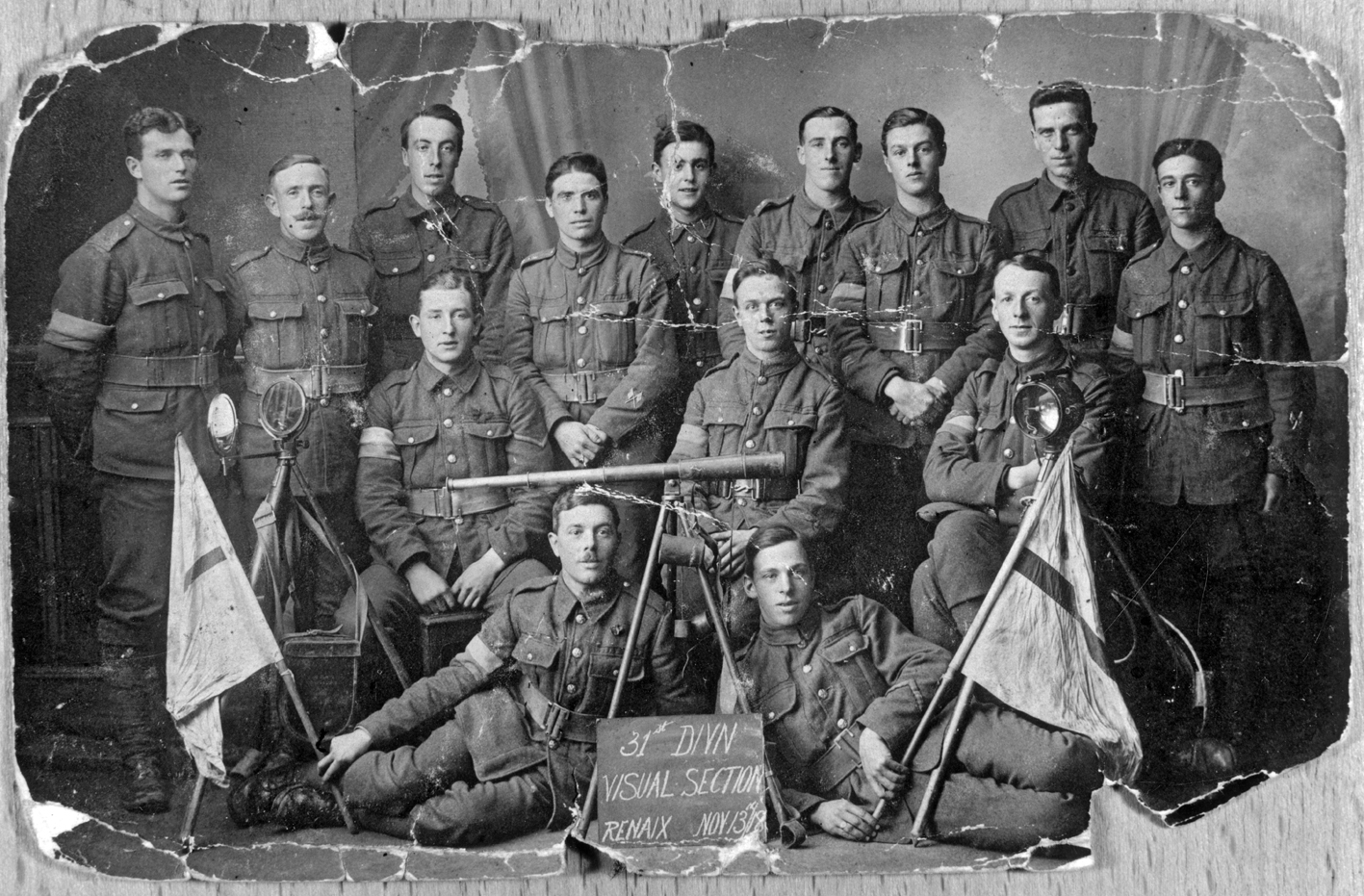As the anniversary of the Battle of the Somme nears, our Assistant Curator, Lizzie Labres agreed to write a blog post about how it affected the men of Bradford who were involved. She writes:
As we approach the centenary of the Battle of the Somme it seemed fitting to write a blog about the men of Bradford who fought in the battle. The 1914 German invasion left large areas of France and Belgium under German control. The Battle of the Somme was the main offensive of 1916, were the French and British Armies met, north of the River Somme. Losses at the Battle of Verdun, at the beginning of 1916, put General Sir Douglas Haig, the British Commander in Chief, under huge pressure to attack the German Army without delay. The aims of the campaign were to relieve the French Army at Verdun and weaken the advancing German forces.
During the Battle of the Somme men from Bradford fought at Serre, Thiepval and Fricourt north of the River Somme. 1,770 Bradford men are believed to have been killed or injured in the first few hours of the battle. In total over 1 million British, French and Germen soldiers were wounded or killed during the campaign. Of all the casualties ½ of the dead were under 22 and around 20% of casualties were under age when they joined up.
In 1914 Britain was the only European power that relied on a volunteer army, made up of the National Reserves and the Territorial Forces. On the 5th of August 1914 Lord Kitchener was appointed the Secretary of State for War. On the 7th of August 1914 he initiated a volunteer recruitment drive which saw 100,000 men enlist in 2 weeks. By mid September 1914 nearly 480,000 men had volunteered. By December 1915 around 2,500,000 men had volunteered to fight for Britain.

Bradford Park Avenue football player, Donald Bell was one of the men who joined at the start of the war. Bell enlisted in the 9th Battalion of the West Yorkshire Regiment, also known as the Green Howards, in November 1914. In July 1916, at the Battle of the Somme, the Battalion was placed in reserve near the town of Albert. On the 5th of July 1916 the Battalion was ordered to attack the German Horseshoe trench, coming under heavy machine gun fire. Donald Bell was awarded the Victoria Cross for bravery during this attack. He is the only professional football player to be awarded the VC.
In Bradford, men formed their own Citizen’s Army League and by September 1914 1000 men had enlisted and formed the new 16th Battalion of the West Yorkshire Regiment; the 1st Bradford Pals Battalion. By February 1915 a further 1000 men had enlisted. They formed the 18th Battalion of the West Yorkshire Regiment; the 2nd Bradford Pals Battalion.

The 1st Battalion of Bradford Pals was the lead Battalion at the fortified town of Serre. By the end of the first day 527 men were killed or wounded. The 2nd Battalion of Bradford Pals were involved in a trench raid on the evening before the battle. In this raid 512 men were killed or wounded. In the first two days of the Somme the Bradford Pals Battalions saw casualties of 1039 men, out of an initial 2000 men who had joined the battalions.
Bradford Pals – The Prince of Wales Own West Yorkshire Regiment
At the outbreak of war Bradford already had its own Territorial Army regiments. The 1/6th Battalion of The Prince of Wales Own West Yorkshire Regiment was formed in 1908 and was based at Belle Vue Barracks in Manningham. The Battalion consisted of mainly textile workers from the local factories, along with Officers from professional backgrounds such as Doctors and Solicitors. The Battalion met on a weekly basis and Officers and men trained together, forming a strong bond within the Battalion. At the beginning of the war the Battalion was made up of 588 men. On the 1st of July 1916 the men waited in reserve at Thiepval and by the late afternoon they were called into action. Over the first two days of the battle the Battalion saw casualties of 264 men.
The 10th Battalion West Yorkshire Regiment was formed in York in 1914 and was deployed to France in July 1915. The Battalion was sent into action at Fricourt on the 1st of July 1916 and suffered enormous casualties. On the 1st of July 310 soldiers from this regiment were killed.
The Battle of the Somme continued on until November 1916. By the end of the campaign the Allied forces had advanced only 6 miles, however this was the largest advanced made by the Allied forces since the Battle of Marne in 1914. The Battle of the Somme was the largest and one of the bloodiest battles of World War 1.
To mark the centenary of World War 1 and the contribution of Bradford’s people, Bradford Council, in conjunction with the Telegraph and Argus, launched an appeal in 2014 to raise funds for a memorial in France. The memorial will hopefully be unveiled in July this year as a lasting reminder of the sacrifices made during World War 1.
The Lord Mayor’s office also bought a poppy from the Tower of London Art Installation, to serve as a permanent tribute to those from across the district who lost their lives during the conflict. The poppy is on permanent display at Bradford City Hall. A Tower of London Poppy has also been donated to Bradford Museums & Galleries as a memorial to Walter Sefton, who died in 1917. This poppy is on permanent display at Bradford Industrial Museum.



19 Responses
You have only my sharp brain cells to rely upon. But I am trying to piece together an incident that happened on the first day of July 1916 battle of the Somme and would be grateful if anyone could come to my assistance and say if what I state is true. My grandfather (Saddler: Reg No 16719 James Bartlett of the 9th Batt of the West Yorkshire Regiment) with his brother Joseph Bartlett who was in the Durham Light Infantry when an incident took place between an Officer and the two brothers in question, where upon whilst manning the big guns Joseph was instructed to elevate the guns higher but he refused to do so because the shells were already falling on the D.L.Infantry on one side of the trajectory and the Leeds Bradford Pals on the other side of them.The officer, (name unknown) threatened to shoot my great uncle Joseph but his brother James who witnessed the incident stepped up and took the revolver from the officer and struck him to the floor and shot him, stating that nobody threatens his brother.Both brothers made history as to being the only brothers to be FGCM together in the same court 3rd Aug 1916 and the record states that they both received 3 years hard labour in Rouen Prison but my Grandfather James Bartlett told me Ron Bartlett his grandson, that he was sentenced to death but when the redcaps came to take him down to execute him, he once again showed his resolve and smote the three of them to the floor and escaped.Once again James made history by being the only person to receive the death sentence and live to tell the tale. I have not given you the full story of what happened to him after his escape because that is another story in itself and I think you must admit this is one story that should been made into a film with true facts.
What is the follow on to this story ? I am fascinated – my gt grandad was in Bfd Pals
i have a special sigarette case from the bradford pals.
Dear Piet – please can you contact our Social history curator, Heather Millard to provide some additional information? She’ll send an email clarifying what information might be required.
I am from Bradford, and despite being a large regional city, we are a small inner city.
Our elders say that entire streets were thrown into mourning, whole factories, entire families of men were killed, and they say everyone in Bradford knew SOMEONE who was killed in the Somme offensive.
an entire generation of Our young men were killed in a single day, and the devastation at home was too much for the people to cope with.
Being such a small town, despite our city status, the depth of the loss in Bradford in particular became a rallying cry against the use of the PALS style battalion structure, and the military abandoned the PALS style battalions vey shortly afterwards in favour of far wider spread out regiments, so that if large scale loss of life occurred again, the heartache wouldn’t be so concentrated as it was under the pals system.
henceforth, our little City of Bradford has an eternal affiliation with the PALS battalions, and anything related to our fellow Bradfordian who died during the commission of their duties is invaluable.
Thank you.
My great great uncle Tom Parker died during the battle of the Somme on July 1st. He was only 19 years old, 16th Batallion.
My grandfather was a member of the Bradford pals July 1st 1916 , his name was William Ewart Bottomley, I still have his medals mounted hanging on my wall,he was wounded but survived. died aged 66 due to chlorine gas inhaled in another battle
I’m doing some research on Thomas Herbert Russell, he was a Captain in the 16th West Yorks (1st Bradford Pals). He was born in Glamorgan but moved to Bacton, Norfolk. He occupation was a teacher and first lived at Red House (Now a caravan park where I work). I was wondering if you have any information on this officer?
My relative Thomas Blakey Brogden was killed on that dreadful first day. He was 20 years of age. God bless him.
Hi Barry, I’ve seen you are a relative to T.B Brogden I’m not quite sure if it’s the same person but everything links up with my relative, may I ask do you have his medal? Because I have a medal with the name T.B Brogden imprinted on the back of it as he was my great great uncle?
My great great grandfather was John Thomas Brogden of the Kings Own Yorkshire Light Infantry, killed in action on Flanders’s Fields in Feb of 1917. Apparently named on Thiepval Memorial
My Great Uncle Stephen Pearson 16/1420 16th Battalion West Yorkshire Regiment (Bradford Pals) enlisted in June 1915.
He Married his sweetheart Lizzie in August 1915.
He entered the theatre of war in Egypt in December of 1915.
He was shipped to France in March 1916.
He died of his wounds on the 1st July 1916. The first day of The Battle of The Somme. At the attack on Serre.
He is buried at Serre Road No1. Cemetery. He was 26.
His younger brother Thomas Pearson enlisted in May 2015. Age only 18.
He entered the theatre of war in November 2015 in The Balkans. Fought at Gallipoli with the 8th Battalion Northumberland Fusiliers. He shipped to Egypt in January 1916 then to France in July 1916.
He was killed at The Battle for Thiepval Ridge, part of The Battle of The Somme.
His name is on The Thiepval Memorial to the missing. Age 19.
I’ve b in n trying to trace my Great Grandfather. Bartholomew Gallagher he had two brother who also served in 2 nd battalion of the prince of wales own. He r side around west bowling. Maybe Round st ? He was KIL at Ypres , as where his two brothers. Grewt Grandma as many others mothers daughters and t, never recovered. As was such decimation, as been mentioned, I am finding it hard jute difficult to trace. Great great Grandfwther came from limerick. Ireland to working texilew as was the passage of families into Bradford at this time. Can anyone please ovide information or links as well o how I can gain more research at all.
Hi Denise.
For guidance into further looking into your family history, we’d probably recommend contacting the Local Studies Library, as they tend to hold most documentary evidence – or can point you where to look. As a rule of thumb, museums tend to look after things, and libraries/archives after the documents.
Bartholomew was in the East Yorks Reg’t 20569 and died of a gun shot wound 27 9 1916 He is buried at LUCKNOW CANTONMENT MILITARY CEMETERY Dilkusha, Bengal, India
Brother Michael served in the Duke of Wellington (West Riding) Reg’t 24188 and was discharged from the Labour Corp in 1919
Other brother Joseph was in the 2nd Battalion West Yorkshire 203992 was killed in action on 27th November 1917 in Belgium. He is buried at TYNE COT CEMETERY West-Vlaanderen, Belgium.
Hope that helps a bit
The picture in the story above of the bradford pals camp and a soldier walking by two ladies is very interesting to me. I recently found out my great grand father was a private in the 18th and was at that camp pictured in the background. Has the soldier in the picture ever been identified? My relatives name was Arthur Reynolds.
Hi I can’t find the person who said Thomas Blakey Brogden. But I can tell you now I have his medal as he was my great great uncle, My great nan was Mary his niece and my dad is Mary’s grandson and I have even found his name when I went to Belgium along the top walls of thiepval.
my great uncle Arthur Johnson 18 Bn West Yorks was killed 1st July battle of Serre. he was only 18 years of age. Have just visited his grave, Euston Road, Colincamp. It was still upsetting but what a beautiful cemetery. so quiet and peaceful and well looked after
My grandfather, Frank Hardy, was in the Bradford Pals. All I know is that he was taken prisoner shortly after arriving in France. No one in the family is left to confirm what I have been told – that he was forced to work in a mine by his German captors. I do know he came home suffering from malnutrition, and he probably suffered what we would now call ptsd. He lived in Bierley and worked as a pinsetter.
Any suggestions on how I could find out more about when he joined the Pals, when he was taken prisoner etc?